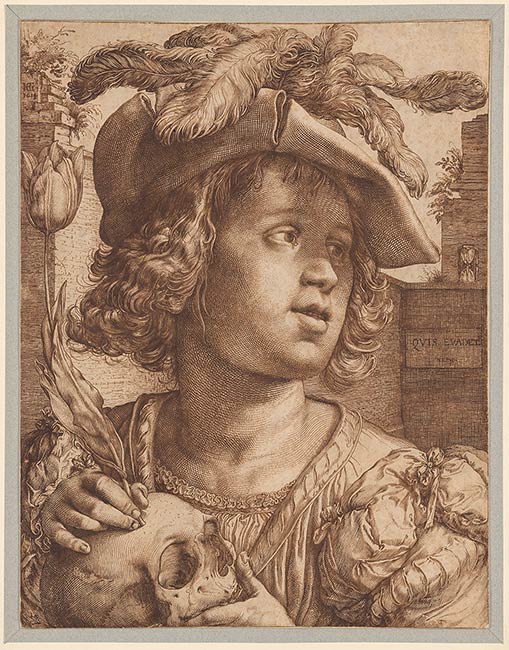
Hendrick Goltzius's large pen and ink drawing is among the most virtuosic artworks in the Morgan's collection, if not the broader history of draftsmanship. He skillfully depicts a young man, swathed in sumptuous garments adorned with bows and feathers, holding a tulip and a skull. The tousled-haired youth--still the picture of innocence with his smooth and supple baby face--is an early seventeenth-century vision of beauty that remains every bit as striking today. Goltzius matched his bravura drawing technique with his subject; steady and precise ink lines produce an exquisitely detailed artwork that invites admiration and close examination.
Goltzius honed his deft draftsmanship through the study and imitation of other artists. In this drawing, likely inspired by a Lucas van Leyden print, he executes the work in the manner of a printed engraving. Though Goltzius was an accomplished printmaker, this Federkunststücke (or drawing that imitates engraving) was completed during a period long after he had ceased to work with the graver on copper, partially because of the deterioration of his eyesight.
This life-size “fantasy portrait,” so-called because it depicts an imagined rather than real person, is among the last of Goltzius's large showpieces that he had produced throughout his career. His distinctive style was a product of his way of gripping drawing implements--a technique he developed as a result of a childhood accident that burned his right hand and fused together several fingers.
On the center left side of the print is the Latin inscription (Quis evadet? Nemo / Who escapes? No man). This message, alongside skull, tulip, and small hourglass in the drawing's background, indicate that the drawing is a vanitas, a memento mori, or reminder of the transience of life. Goltzius' work suggests that even the vital young man with the passing of time will fade and decay like the short-lived tulip. The youth's right hand grasps the tulip's stem in a manner perhaps reminiscent of the same virtuosic grip Goltzius used on his quill or engraving burin. This subtle gesture may reveal the artist's meditation on furtive beauty, and those who wield it. The present drawing proved prophetic, for Goltzius died just two years later, having made an artful life from a life of art making.
Watermark: none visible through lining.
Signed with monogram and dated at upper left, in brown ink, "HG" (interlaced) / 1614". Lettered by the artist at right center, in brown ink, "QVIS EVADET / NEMO" (Who escapes? No man).
MacGowan, John, -1803, former owner.
Mayor, William, 1826-1892, former owner.
Roupell, Robert Prioleau, 1798-1886, former owner.
Whitehead, Jeffrey, former owner.
Murray, Charles Fairfax, 1849-1919, former owner.
Morgan, J. Pierpont (John Pierpont), 1837-1913, former owner.
Collection J. Pierpont Morgan : Drawings by the Old Masters Formed by C. Fairfax Murray. London : Privately printed, 1905-1912, III, 145.
Stampfle, Felice. Rubens and Rembrandt in Their Century: Flemish and Dutch Drawings of the Seventeenth Century from The Pierpont Morgan Library. New York : Pierpont Morgan Library, 1979, no. 39, repr.
Stampfle, Felice, with the assistance of Ruth S. Kraemer and Jane Shoaf Turner. Netherlandish Drawings of the Fifteenth and Sixteenth Centuries and Flemish Drawings of the Seventeenth and Eighteenth Centuries in the Pierpont Morgan Library. New York : Pierpont Morgan Library, 1991, p. 42-43, no. 69.
From Leonardo to Pollock: Master drawings from the Morgan Library. New York: Morgan Library, 2006, cat. no. 33, p. 72-73.
100 Master drawings from the Morgan Library & Museum. München : Hirmer, 2008, no. 43, repr. [Felice Stampfle]

